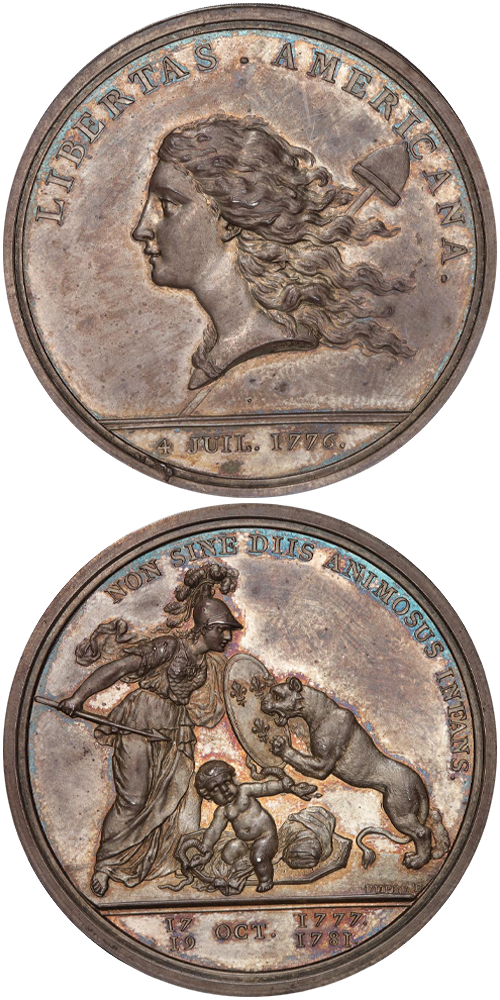Betts-615
1783 Libertas Americana Medal
Catalog Reference
Adams-Bentley 15
A.J.N., II, 63; XXIII, 33
There is almost nothing we can say about the Libertas Americana medal that has not been said before. It is the most recognizable early American medal, the unanimous choice as #1 in the 100 Greatest Medals and Tokens book, and the inspiration for many of the United States coinage designs of the 18th century. It is legendary beyond its rarity, historic beyond its celebrated creation narrative, and important far beyond the world of numismatics.
While not properly a part of the Comitia Americana series - it was a medal authorized by Benjamin Franklin as an individual, not the Continental Congress - the Libertas Americana medal has been adopted into this group ever since Thomas Jefferson saw fit to place one in George Washington's set of Comitia Americana medals in the summer of 1789. By that time, the medal was several years old, as it had been completed and distributed by Franklin in the spring of 1783. Franklin sent his medal far and wide, in France, in the United States, and beyond. His postal accounts show that in April 1783 he twice hired a carriage to special deliver his medal to its recipient. Jefferson had one on display at Monticello, inventoried as "a medal by Dr. Franklin." The Dutch artist Johann-Georg Holtzhey had a friend write to John Adams to ask how he and his friends could obtain one. As the medals found their homes in April and May 1783, Franklin's mailbox filled up with thank you notes from across the continent. On April 15 of that year, Franklin sent a bundle of them to Philadelphia to hand out to the members of Congress, including a silver one for Congress' president, future Mint Director Elias Boudinot.
In September 1783, Franklin wrote to Boudinot "I am happy that both the Device and Workmanship of the Medal are approv'd with you, as they have the good Fortune to be by the best Judges on this side the Water. It has been esteem'd a well-timed as well as a well-merited Compliment here, and has had good Effects. Since the two first which you mention as received, I have sent by different Opportunities so many as that every Member of Congress might have One. I hope they are come safe to hand by this time." Boudinot confirmed their arrival and described how he parceled them out: "I have received the additional number of Medals, which, not having any particular directions from you, I distributed among the Members of Congress, presented one to the Governor of each State, and the Ministers round Congress."
Every Libertas Americana medal was once handled by Franklin, every great American and Frenchman of the era knew about the medal and associated it with Franklin, and every Libertas Americana medal surviving today has a remarkably historic provenance, whether it is fully documented or not.
The quoted descriptions of the medal come from the explication published in France in May 1783, quite possibly written by Franklin himself. This explication was printed as a leaflet and intended to accompany the medal itself.
Obverse: "The Head representing American Liberty has its tresses floating in the air, to shew that she is in activity. The Cap carried on a Spear is her Ensign. The Date underneath is that of the Declaration of Independence."
Reverse: "The United States of America are represented by an Infant Hercules, cradled in a Buckler to shew that they are nursed in War. A Leopard, representing England, comes with two serpents to destroy the Infant. France represented by a Minerva, comes armed to his succour, and under her protection he strangles the two serpents, while she guards him from the Leopard, by her shield marked with Fleurs-de-Lis. The Legend is a line of Horace, importing that the Infant was not without divine assistance. The Dates below are those of the two Capitulations of Saratoga & York-Town, whereby two entire English Armies that had enter'd and ravaged the United States with fire & sword, were extinguished." In Franklin's symbolism, this depiction recalls Hera, the stepmother of Hercules, releasing two snakes to kill Hercules in his cradle; those two snakes were the armies of Burgoyne (defeated at Saratoga) and Cornwallis (defeated at Yorktown).
The example to the left was sold by Stack's Bowers Galleries in the June 2022 Showcase Auction, where it realized $198,000.






